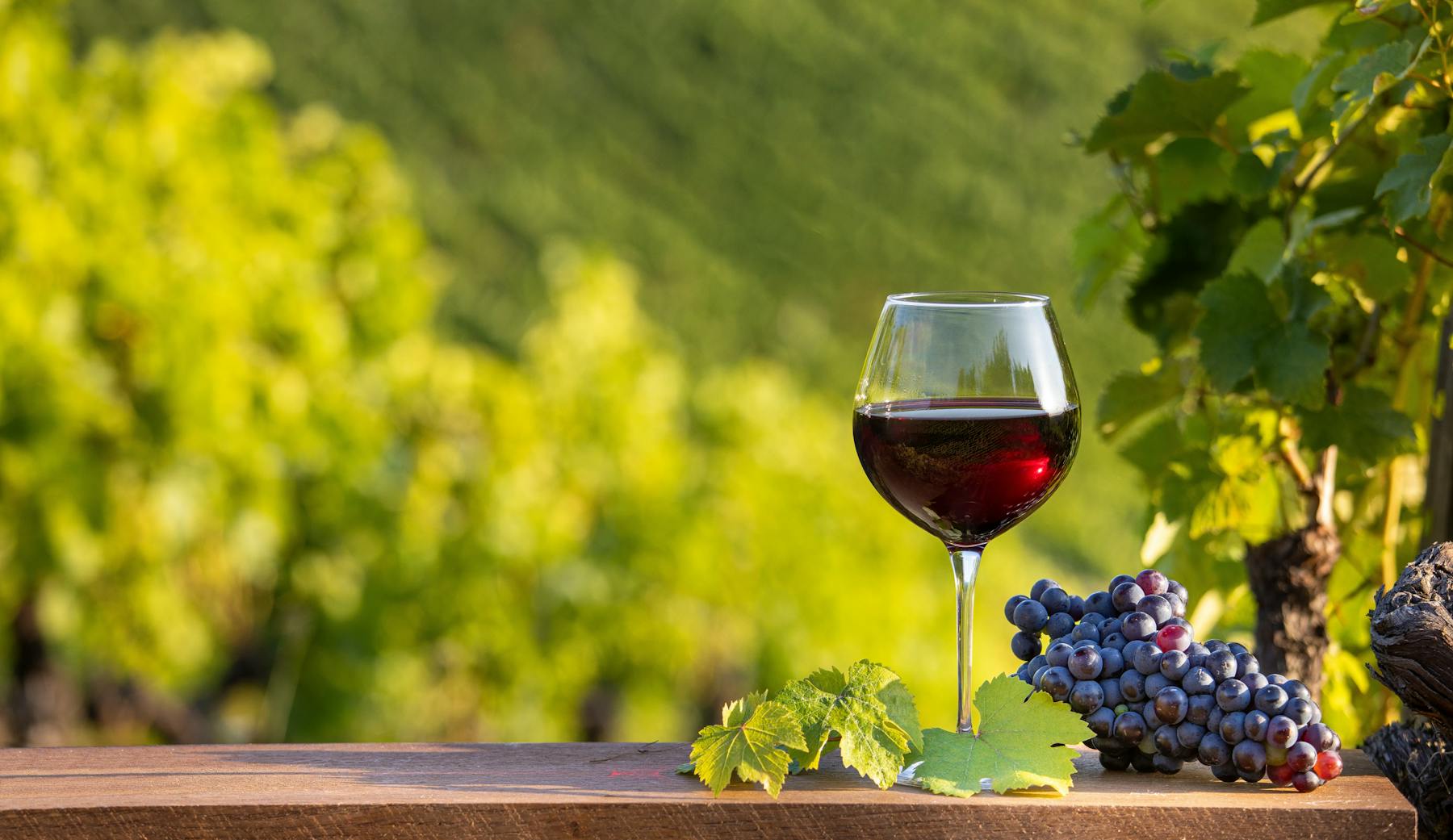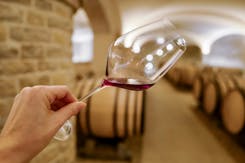- Wine world
Red grape varieties guide
- Wed, Jun 19, 2024 at 10:00

Cabernet Sauvignon
Origin: Bordeaux, France
Characteristics of Cabernet Sauvignon: Cabernet Sauvignon is often described as the king of red grape varieties. It produces robust, tannic wines with aromas of blackcurrant, green pepper, cedar and tobacco. These wines are generally aged in oak barrels, giving them notes of vanilla and spice.
Growing regions: As well as Bordeaux, this grape variety is grown in California (Napa Valley), Australia (Coonawarra), Chile (Maipo Valley) and Italy (Tuscany).
Wine and food pairing:
- Grilled red meat (steak, entrecote)
- Game (venison, wild boar)
- Dishes in sauce (boeuf bourguignon)
- Aged cheeses (cheddar, aged gouda)
Merlot
Origin: Bordeaux, France
Characteristics of Merlot: Merlot is appreciated for its roundness and suppleness. It offers red and black fruit flavours such as cherry, plum and blackberry, with hints of chocolate and spice. Less tannic than Cabernet Sauvignon, it is often used to soften Bordeaux blends.
Growing regions: Merlot is widely grown in France (particularly in Pomerol and Saint-Émilion), Italy, the United States, Australia and Chile.
Food and wine pairings:
- White meats (roast chicken, turkey)
- Simmered dishes (veal casserole)
- Pasta with rich sauces (lasagne, spaghetti bolognaise)
- Mild cheeses (Brie, Camembert)
Pinot noir
Origin: Burgundy, France
Characteristics of Pinot Noir: Pinot Noir is renowned for its finesse and complexity. It produces elegant wines with aromas of cherry, raspberry, undergrowth and mushroom. On the palate, it is often light to medium-bodied, with silky tannins and refreshing acidity.
Growing regions: Burgundy remains the undisputed benchmark, but Pinot Noir is also successfully grown in California (Sonoma, Carneros), Oregon, New Zealand (Martinborough, Central Otago) and Germany (Spätburgunder).
Food and wine pairings:
- Poultry (duck à l'orange, roast chicken)
- Oily fish (salmon, tuna)
- Mushrooms (mushroom risotto)
- Mature cheeses (comté, gruyère)
Syrah
Origin: Rhône Valley, France
Syrah characteristics: Syrah produces powerful, spicy wines with aromas of blackberry, blueberry, black pepper and olive. In Australia, where it is known as Shiraz, it can also develop notes of chocolate and eucalyptus.
Growing regions: This grape variety flourishes in the northern Rhône Valley (Hermitage, Côte-Rôtie), but also in the Barossa Valley in Australia, South Africa, the United States and Spain.
Food and wine pairings:
- Grilled meats (lamb, beef)
- Spicy food (Mediterranean cuisine, tajines)
- Cold meats (sausage, chorizo)
- Strong cheeses (Roquefort, Bleu d'Auvergne)
Grenache
Origin: Spain
Characteristics of Grenache: Grenache is a generous grape variety, often used in blends. It has aromas of strawberry, raspberry, white pepper and spices. On the palate, it is rich and warm, with a fine concentration of fruit and a moderate tannic structure.
Growing regions: This variety is predominant in Spain (under the name Garnacha), in the southern Rhône Valley (notably Châteauneuf-du-Pape) and in southern France (Languedoc-Roussillon). It is also found in California and Australia.
Food and wine pairings:
- Mediterranean dishes (paella, ratatouille)
- Grilled meats (lamb chops)
- Tajines and couscous
- Cheeses (manchego, goat's cheese)
Sangiovese
Origin: Italy
Characteristics of Sangiovese: Sangiovese is the main grape variety used in Tuscan wines such as Chianti and Brunello di Montalcino. It is distinguished by aromas of cherry, plum, violet and dried herbs. On the palate, it has lively acidity and firm tannins.
Growing regions: Mainly grown in Tuscany, Sangiovese is also found in Umbria and Corsica.
Food and wine pairings:
- Italian cuisine (pasta Bolognese, pizza)
- Grilled meats (pork, beef)
- Antipasti (olives, cold meats)
- Italian cheeses (parmesan, pecorino)
Tempranillo
Origin: Spain
Tempranillo characteristics: Tempranillo is the flagship grape variety of Rioja and Ribera del Duero. It offers aromas of strawberry, plum, tobacco and leather. Tempranillo wines can be fruity and light or rich and complex, depending on how they are aged in oak.
Growing regions: As well as Rioja and Ribera del Duero, it is found in Toro, Valdepeñas and Portugal (where it is called Tinta Roriz or Aragonez).
Food and wine pairings:
- Tapas (chorizo, Iberian ham)
- Stews (beef stew, coq au vin)
- Grilled meats (lamb, pork)
- Spanish cheeses (idiazábal, manchego)
Malbec
Origin: South-West France (Cahors)
Characteristics of Malbec: Malbec is known for its plum, black cherry and violet aromas, with a medium to high tannin structure.
Growing regions: Argentina (Mendoza), France (Cahors), United States, Chile.
Food and wine pairings:
- Grilled meats (steak, lamb)
- Strong cheeses (blue cheese, Roquefort)
- Spicy dishes (chilli con carne)
Nebbiolo
Origin: Piedmont, Italy
Characteristics of Nebbiolo: Nebbiolo is renowned for its powerful tannins and high acidity, with aromas of rose, cherry, liquorice and truffle.
Growing regions: Italy (Barolo, Barbaresco).
Food and wine pairings:
- Braised meats (osso buco)
- Pasta with truffles
- Mature cheeses (parmesan, pecorino)
Other red grape varieties
Although the best-known red grape varieties such as Cabernet Sauvignon, Merlot and Pinot Noir often dominate conversations about wine, there are a wide variety of lesser-known red grape varieties that are also worth exploring. Varieties such as Blaufränkisch in Austria, Mencia in Spain and Sagrantino in Italy bring unique characteristics and distinct aromatic profiles that enrich the global wine panel. Discovering these lesser-known grape varieties not only diversifies your tasting experience, but also allows you to appreciate the richness and complexity of the world of wine in all its splendour.
- Zinfandel: robust and fruity, with blackberry and raspberry flavours.
- Barbera: high acidity with aromas of cherry, raspberry and liquorice.
- Touriga Nacional: Port's main grape variety, with aromas of black fruit, violets and spices.
- Carménère: notes of green pepper, red fruit and chocolate, popular in Chile.
- Sagrantino: tannic Italian grape variety with aromas of blackberry, black cherry and earth.
- Mourvèdre: spicy and rich, with aromas of black fruit, pepper and game.
- Petite Sirah: known for its powerful tannins and aromas of blackberry and black pepper.
- Cabernet Franc: lighter than Cabernet Sauvignon, with aromas of raspberry, pepper and herbs.
- Cinsault: supple and fruity, often used in blends.
- Gamay: Beaujolais grape variety, light and fruity with cherry and strawberry aromas.
- Tannat: very tannic, with aromas of plum, blackcurrant and tobacco.
- Aglianico: powerful and structured, with aromas of black cherry, tobacco and earth.
- Nero d'Avola: a Sicilian variety with aromas of plum, black cherry and liquorice.
- Negroamaro: rich and spicy, with aromas of black fruit and herbs.
- Dolcetto: supple and fruity, with aromas of blackberry and liquorice.
- Carignan: a rustic variety with aromas of black fruit, spices and leather.
- Frappato: light and fruity, with strawberry and raspberry aromas.
- Lambrusco: often sparkling, with red fruit aromas and lively acidity.
- Bobal: a rich Spanish variety with blackberry and liquorice aromas.
- Blaufränkisch: known for its aromas of black fruit and spices, popular in Austria.
- Mencia: fruity and floral, with aromas of cherry and violet.
Discovering red grape varieties
Red grape varieties are the beating heart of red wines, each making a unique contribution to the diversity and richness of the wine world.
Exploring these grape varieties will give you an even greater appreciation of the subtleties of red wines. So, the next time you choose a bottle, take a moment to think about the grape variety behind the label. There's a whole world of flavours to be discovered in every glass!




